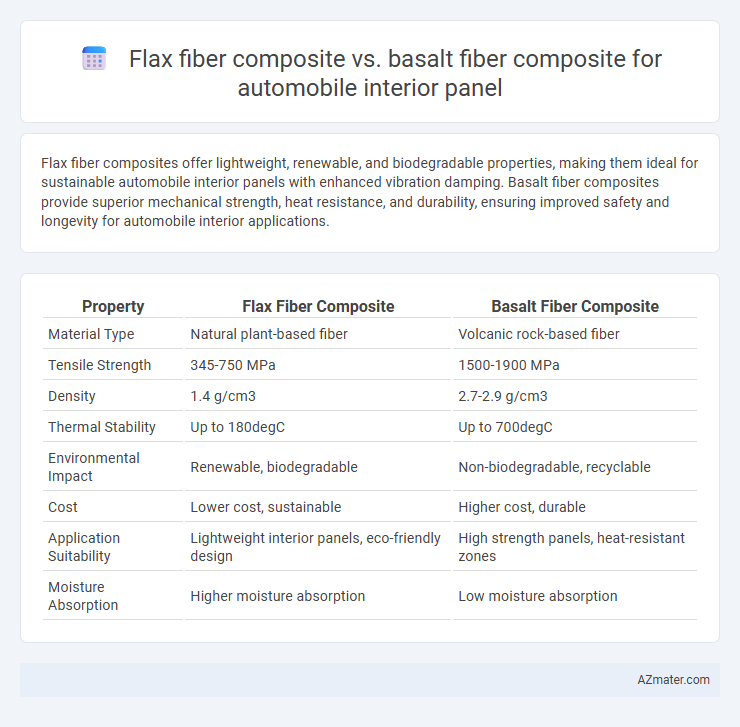Flax fiber composites offer lightweight, renewable, and biodegradable properties, making them ideal for sustainable automobile interior panels with enhanced vibration damping. Basalt fiber composites provide superior mechanical strength, heat resistance, and durability, ensuring improved safety and longevity for automobile interior applications.
Table of Comparison
| Property | Flax Fiber Composite | Basalt Fiber Composite |
|---|---|---|
| Material Type | Natural plant-based fiber | Volcanic rock-based fiber |
| Tensile Strength | 345-750 MPa | 1500-1900 MPa |
| Density | 1.4 g/cm3 | 2.7-2.9 g/cm3 |
| Thermal Stability | Up to 180degC | Up to 700degC |
| Environmental Impact | Renewable, biodegradable | Non-biodegradable, recyclable |
| Cost | Lower cost, sustainable | Higher cost, durable |
| Application Suitability | Lightweight interior panels, eco-friendly design | High strength panels, heat-resistant zones |
| Moisture Absorption | Higher moisture absorption | Low moisture absorption |
Introduction to Natural Fiber Composites in Automotive Interiors
Flax fiber composites offer lightweight, biodegradable alternatives with high specific strength ideal for eco-friendly automobile interior panels, reducing vehicle weight and carbon footprint. Basalt fiber composites provide superior thermal stability, excellent mechanical properties, and enhanced durability compared to traditional glass fibers, improving longevity in automotive interiors. Both materials contribute to sustainable design by combining natural or mineral-based fibers with polymer matrices, enabling improved performance and environmental benefits in automotive applications.
Overview of Flax Fiber Composite Materials
Flax fiber composite materials offer a lightweight, biodegradable alternative with excellent mechanical properties, making them suitable for automobile interior panels seeking sustainability and reduced environmental impact. These composites exhibit good tensile strength, low density, and improved vibration damping compared to traditional synthetic fibers. Their natural origin and ease of processing contribute to cost-effective manufacturing while providing adequate durability and enhanced aesthetic appeal in automotive applications.
Overview of Basalt Fiber Composite Materials
Basalt fiber composite materials offer exceptional mechanical strength, thermal resistance, and durability, making them highly suitable for automobile interior panels. Derived from volcanic rock, basalt fibers have superior tensile properties and chemical stability compared to conventional fibers, providing enhanced impact resistance and long-term performance. These composites also exhibit excellent lightweight characteristics and eco-friendliness, contributing to improved fuel efficiency and sustainability in automotive applications.
Mechanical Properties: Flax vs Basalt Fiber Composites
Flax fiber composites exhibit lower tensile strength and stiffness compared to basalt fiber composites but offer superior flexibility and impact resistance, making them suitable for lightweight, energy-absorbing automobile interior panels. Basalt fiber composites demonstrate higher mechanical properties, including tensile strength up to 3000 MPa and modulus exceeding 90 GPa, providing enhanced structural integrity and durability in demanding automotive applications. The superior thermal stability and resistance to wear of basalt fibers contribute to longer service life, whereas flax fibers present advantages in biodegradability and cost-efficiency.
Thermal and Fire Resistance Comparison
Flax fiber composites offer moderate thermal resistance with decomposition temperatures around 250-300degC, making them less suitable for high-heat automotive interior panels compared to basalt fiber composites, which can withstand temperatures up to 700degC without significant degradation. Basalt fiber composites exhibit superior fire resistance, characterized by low flammability, no toxic smoke emission, and excellent heat insulation properties, enhancing passenger safety in vehicle interiors. The enhanced thermal stability and fire retardant capabilities of basalt fiber composites make them preferable over flax fibers for automotive applications demanding stringent thermal and fire performance.
Environmental Impact and Sustainability Analysis
Flax fiber composites exhibit superior environmental benefits due to their biodegradability and renewable nature, significantly reducing carbon footprint in automobile interior panels compared to basalt fiber composites. Basalt fibers, derived from volcanic rocks, offer excellent durability and thermal stability but involve energy-intensive production processes contributing to higher environmental impact. The sustainability analysis favors flax fibers for eco-friendly vehicle design, emphasizing lower lifecycle emissions and ease of recycling in automotive applications.
Weight and Density Considerations for Interior Panels
Flax fiber composites exhibit a lower density, around 1.2-1.4 g/cm3, compared to basalt fiber composites, which typically range from 2.5 to 2.7 g/cm3. This significant difference in density directly contributes to lighter automobile interior panels when using flax fiber, enhancing fuel efficiency and reducing vehicle weight. Weight savings from flax fiber composites make them preferable for applications prioritizing lightweight design without compromising structural integrity in interior automotive components.
Cost and Availability in the Automotive Industry
Flax fiber composites offer a cost-effective alternative to basalt fiber composites due to the lower raw material price and easier processing techniques, making them attractive for large-scale automotive interior panel applications. Basalt fiber composites, while generally more expensive, provide enhanced durability and higher thermal resistance but face limited availability and higher manufacturing costs in the automotive sector. The widespread cultivation of flax and established supply chains contribute to its greater availability and cost efficiency compared to basalt fibers, which are less common and more costly to produce for automotive interior components.
Manufacturing Processes and Compatibility
Flax fiber composites for automobile interior panels offer eco-friendly, lightweight properties with manufacturing processes compatible with resin transfer molding (RTM) and compression molding, ensuring easy integration with bio-based resins. Basalt fiber composites provide superior mechanical strength and thermal stability, typically processed using wet lay-up, vacuum infusion, or RTM techniques, aligning well with thermosetting matrices like epoxy or polyester resins. Both materials exhibit compatibility with existing automotive manufacturing lines but differ in processing temperatures and matrix adhesion requirements, influencing cycle times and overall production efficiency.
Applications and Future Trends in Automotive Interior Panels
Flax fiber composites offer lightweight, sustainable alternatives for automotive interior panels with enhanced vibration damping and sound insulation properties, making them ideal for eco-friendly vehicle designs. Basalt fiber composites provide superior mechanical strength, thermal stability, and fire resistance, supporting applications in high-performance and luxury vehicle interiors. Future trends indicate increasing integration of hybrid composites combining flax and basalt fibers to optimize sustainability, durability, and cost-effectiveness in automotive interior panel manufacturing.

Infographic: Flax fiber composite vs Basalt fiber composite for Automobile interior panel
 azmater.com
azmater.com